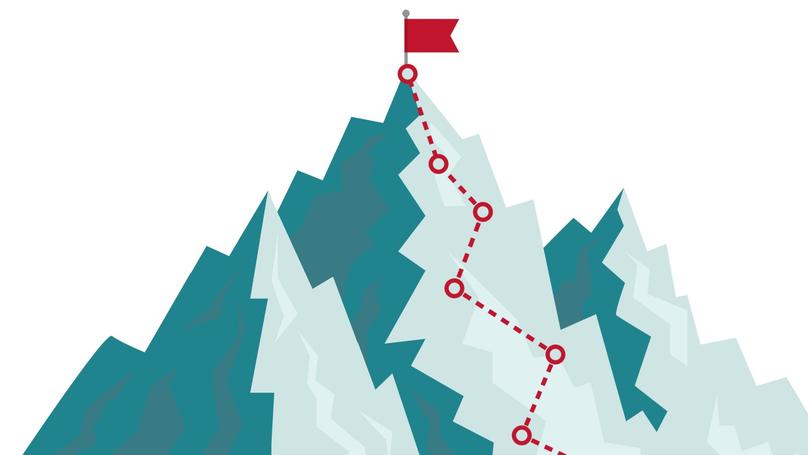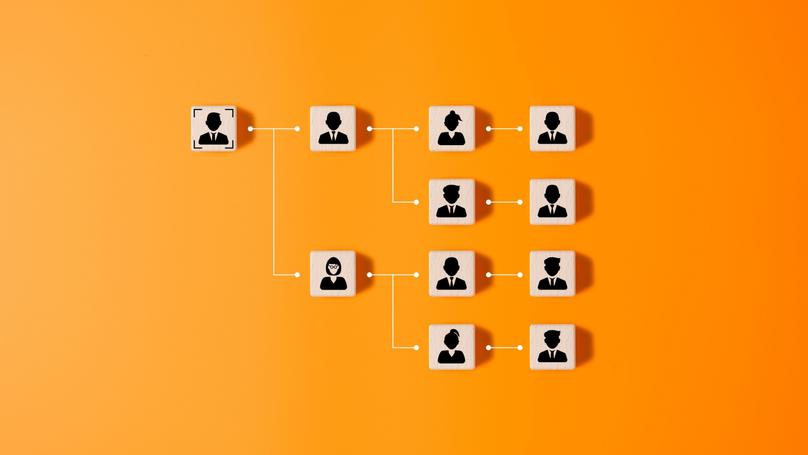How to build a career map and follow it
At some point, every professional, even the most seasoned, encounters career stagnation. You might experience self-doubt and need more motivation and engagement in your work.

However, this is entirely normal as long as you proactively address stagnation over time and seek fresh professional growth opportunities. Creating a career map can invigorate your professional journey and prevent stagnation! Let's delve into the details and explore how to use it effectively.
What is a career map, and how does it differ from a plan?
A career map is a tool for visualising your personal and professional development trajectory. It can be compared to a navigator who reveals the route to your desired goal.
Unlike a career plan, a career map provides a clearer system for navigating from one career point to another. Additionally, a career map encompasses various options for achieving professional growth and development, along with a list of necessary resources and specific deadlines. Similarly, a career map contains a starting point, including details about your current work position, salary, desired endpoint, and ideally, what you want to achieve, as well as various intermediate points essential for reaching your main professional goal.
A career map is a versatile tool for overcoming stagnation or sluggishness in your professional development. It will be equally valuable at the beginning of your career when faced with multiple development paths when you don't know which one to choose, and even when battling professional complexes like impostor syndrome.
Five more reasons in favour of a career map
First, a career map allows you to determine the main goal to strive for and how to approach your plans with intention. It lets you focus on your career, seize all advancement opportunities, and filter out distractions.
Also, a career map clarifies setting priorities, identifying essential skills and competencies to develop first, recognising knowledge gaps, and expanding your horizons. Creating a career map lets you objectively assess your capabilities and gauge your professional development level.
Likewise, your career map acts as visual evidence of your progress toward your dream career. It's like a trail of achievements, reminding you not to give up halfway. After all, no one is immune to burnout; periods of fatigue and apathy occur to everyone. But believe me, realising how much you have already done and achieved will give you a second wind. Therefore, a career map is an excellent motivator, encouraging continuous improvement.
Simultaneously, a career map ensures you don't work solely for money. An important component of your career map is that it incorporates your desires and aspirations. Following it ensures you stay on your intended path and always maintain sight of your need for self-realisation.
Having a career map can also be an advantage when finding a job because it will significantly simplify the work of an HR manager. Experienced specialists recognise that genuinely passionate individuals typically craft career maps, and ambitious employees create and follow career maps. Meaning they are motivated and ready to work.
How to develop a career map: A step-by-step guide

Coming up with a career map is a lengthy and labour-intensive process involving three key stages. Let's examine each one.
Stage 1. Preparation
During this stage, you'll perform all the necessary preparatory actions to create a comprehensive career map. This map should accurately represent your main goal and the specific steps required to achieve it.
Step 1. Examining the current situation. To do this, create a separate document where you record your achievements, skills, abilities, acquired experience, and competencies. Identify your strengths and weaknesses, and also try to assess your career success objectively. It's essential to be honest with yourself. Remember that even a true professional has flaws and vulnerabilities.
To kick off your career analysis, consider asking yourself the following questions:
-
What position do I hold?
-
How long have I been in this position?
-
What skills and abilities have I developed during this time?
-
Am I happy with the current state of affairs? Why?
-
Am I satisfied with my salary?
-
Am I ready to take on more responsibilities and duties?
-
Am I achieving my full potential?
-
What am I disappointed with, and what would I change?
-
What career prospects are there for me in this company?
You can add to the list of questions. The main thing is to answer them thoroughly and honestly, without hiding even challenging work experiences from yourself.
Step 2. Setting goals. It is vital to determine in advance what you want to achieve in your career. This will help you enhance your efficiency and productivity, boost your chances of success, and instil confidence in your abilities. Remember that the goal must be realistically achievable. Avoid vague statements like "I want to become a professional in my field," "I want a high salary," or "I want to be a sought-after specialist." To achieve a goal, it should be formulated as precisely as possible. For instance:
-
Open your advertising agency.
-
Enter the international market and launch production in another country.
-
Advance from an ordinary supervisor to a managerial position within the company where I currently work.
-
Gain a million followers on Instagram.
-
Develop your own online sales course, etc.
The greater the precision of your goal, the more attainable it becomes. Therefore, you should provide a detailed and comprehensive description of your dream career. For this, you can use the following questions:
-
What is the particular outcome that I would like to achieve?
-
Why do I want to do this, and what will it offer me?
-
How will these changes affect my life?
-
Am I ready for this?
These questions will help you define your goal accurately and determine whether it aligns with your needs.
However, it's essential to remember that you'll need to accomplish numerous intermediate or short-term objectives en route to your primary goal. For example, suppose you want to open your own business. In that case, you will have to draw up a lot of necessary documents, then deal with organisational issues, find personnel and equipment, set up work processes, etc. Suppose your goal is a million subscribers on one of the social networks. In that case, breaking down your goal into smaller ones is essential. For instance, start by gaining 100 thousand subscribers, then 500 thousand, until you reach the coveted million.
Step 3. Establishing deadlines. You must know in advance what period the career map is drawn up for. Modern society is changing rapidly, so the most optimal plan implementation period is 3-5 years. I agree that it is almost impossible to predict the situation that will develop in 10 years. At the same time, drawing up a career map for just one year is also pointless. Therefore, despite this being an individual planning tool, there are general recommendations for drawing up a career map, such as deadlines.
Stage 2. Filling out the map

Once you've examined your current career situation, pinpointed key and intermediate goals, and established implementation deadlines, it's time to dive into the practical aspect: creating your career map!
Step 1. Deciding on the type of career map. When considering the degree of complexity and speed of compilation, there are three types of maps:
-
The visualisation map is the most typical map, demonstrating all available directions for career growth.
-
A scheme map presents various career paths systematically organised based on criteria. This more flexible map format lets you quickly adapt to changing external situations.
-
A framework map is the most accurate tool for professional growth. It enables individuals to identify their development direction and create an effective action plan.
However, there is another, more common category of career map according to your primary goal:
-
A vertical career map or traditional map. It involves career growth in a specific company. It entails identifying necessary actions to secure a higher position or salary increase.
-
A horizontal map aims to move into another field of activity or speciality altogether. Using this map means an employee gains insights into the skills required to transition to another industry. It facilitates a smooth entry and broadens their horizons.
-
A broad map involves not only professional development but also personal development. This type of career map will help you find the desired work-life balance and set up your own schedule so you can devote more time to work and career advancement. However, simultaneously, you can engage in your favourite hobbies, have some alone time, and not give up your personal life.
You can choose the most suitable career map depending on your goal, what resources are required, and how long it will take. For instance, suppose you are currently a supervisor at a construction company but want to become a manager within the next few years. In that case, you should focus on creating a vertical career map. Likewise, if your plans include opening your own business, it is best to use a horizontal one.
Step 2. Selecting a service to draw up a career map. Various online platforms and applications can be used directly for visualisation and systemisation. The most popular among them are:
-
Roadmunk. This service offers users pre-designed templates for planning, strategising, and visualising various data types. At the same time, this service allows manual addition of essential elements. You can grant access to your plan or other documents, invite colleagues for collaborative projects, and engage in discussions. Despite its many features, Roadmunk stands out for its intuitiveness and ease of use.
-
ClickUp. This application allows you to create career maps and check your progress, control the process of achieving your goal, and use various statuses and checklists. You can also leave comments on tasks to be completed, set notifications, and create schedules.
-
Productplan. This platform is specifically designed to visualise the project implementation or planning process. In Productplan, it can be presented as a scale, list, or table. You can effortlessly edit it by dragging and dropping elements, adding new tasks, deleting completed ones, highlighting them with colours, etc.
-
Venngage. This tool enables you to create career maps using a variety of templates and incorporating colours, infographics, and icons. Additionally, you have the option to develop a custom template.
You can explore these services through their free trial plans, typically lasting for the first few days. After checking out these services, you can determine which application best suits your needs for creating, editing, and polishing your career map. Selecting the right application to monitor your progress is just as crucial as addressing the substantial aspects.
Step 3. Exploring opportunities to reach your goals and drawing up a development plan. Firstly, it is necessary to specify what knowledge, skills, and abilities are needed to achieve each goal. There is no need to worry if you lack sufficient experience or skills; career maps are particularly designed to facilitate growth and improvement. Consider enrolling in advanced training programs, pursuing further education, or participating in personal and psychological maturation sessions. Remember that while creating your career map, exploring all available opportunities contributing to your professional growth is essential.
You should also explore the current job market, different job openings, and employer expectations. Still, it would be best if you did not neglect the opportunity for advancement within your current company. It is better to evaluate all possible chances for professional growth. For example, when aiming for a promotion, consider assuming additional responsibilities, participating in scientific conferences or forums, leading projects, and demonstrating your commitment to furthering your career to your managers.
Lectera’s Online Courses by topic
Stage 3. Following the map and monitoring your achievements
Merely creating a career map and waiting for a promotion won't suffice. Regular updates and monitoring of your results are essential.
Step 1. Assessing progress. Assessing intermediate information is vital to achieving swift and tangible results with your career map. Regularly tracking progress is essential. It's the only way to gauge your pace toward your goal, evaluate achievements, and identify challenges. It's best to provide detailed information about your steps, the results achieved, resource allocation, and how these actions impact your career. Only accurate assessment and ongoing monitoring are essential for progressing to the next step.
Step 2. Editing a career map. Regularly assessing progress is essential for adapting your career map based on evolving circumstances. For example, some tasks require more time to complete, and some steps must be abandoned. Furthermore, circumstances can change without any fault on your part due to the rapid pace and unpredictability of the modern world. Therefore, if you want to achieve results, control the process.
Step 3. Continuing to follow the plan and adding to the map. Remember that, alongside analysing and observing the situation, it's crucial to incorporate specific actions into your career map for continued progress. For instance, incorporate emerging prospects and opportunities into your plan and actively participate in events contributing to your career advancement. Ultimately, the greater your opportunities, the quicker you can unlock your full potential.
Therefore, a career map is an effective career and personal growth tool. Although creating it may require significant time and effort, the investment is worthwhile if you don't just want to work for the money, but to build a dream career. By utilising this map, you'll develop a conscious approach to your personal and professional life, establish a work-life balance, and gain confidence in your abilities.
Share this with your friends via:
Latest News

A significant stage in the development of the alternative education system has begun in West Northamptonshire in the UK: the County Council is actively calling on parents, guardians, and trustees to participate in shaping the future of this key area.

Outwoods Primary School in Atherstone, Warwickshire, having experienced deep sadness after the loss of their famous cat, Silla, has found solace in a new pet – a Maine Coon named Aloysius O’Hara.

In modern universities, artificial intelligence, and in particular ChatGPT, is rapidly transforming from a controversial tool into a full-fledged student assistant.

An innovative educational project is gaining momentum in UK primary schools, aiming to change attitudes towards video games.

The Massachusetts Institute of Technology (MIT) presents MIT Learn – a revolutionary online platform that opens a “new front door” to access university knowledge and resources.












 How the Christmas Tree Became the Symbol of the New Year: From Pagan Groves to Sparkling Ornaments
How the Christmas Tree Became the Symbol of the New Year: From Pagan Groves to Sparkling Ornaments
 How to Keep New Year’s Resolutions: A Detailed Guide to Real Change
How to Keep New Year’s Resolutions: A Detailed Guide to Real Change
 6 Life Areas You Have Almost Certainly Never Paid Attention To
6 Life Areas You Have Almost Certainly Never Paid Attention To
 Test. What Winter Dessert Are You?
Test. What Winter Dessert Are You?
 Test: What Kind of Ancient Goddess Are You?
Test: What Kind of Ancient Goddess Are You?
 Test: Which Great Woman Would Invite You for Tea?
Test: Which Great Woman Would Invite You for Tea?
